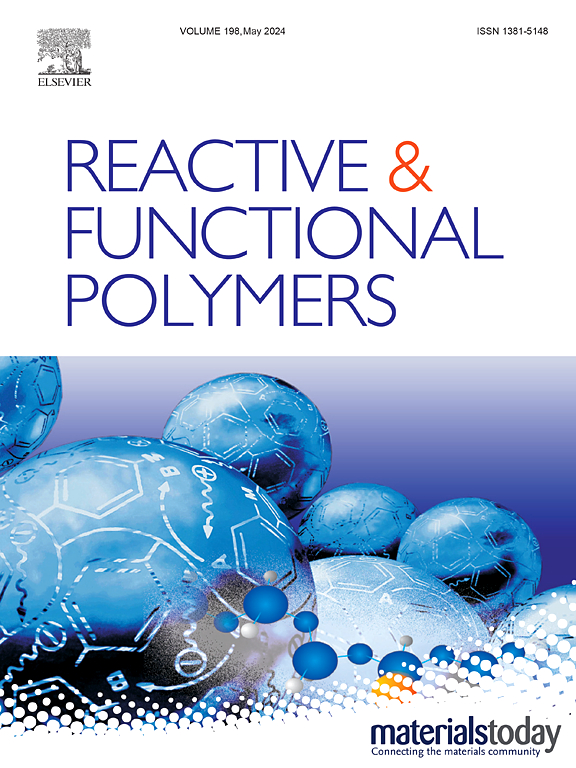水修复的层次聚合纳米复合材料:静电纺丝纳米纤维聚离子液体和光催化去除罗丹明B
IF 5.1
3区 工程技术
Q1 CHEMISTRY, APPLIED
引用次数: 0
摘要
本文提出了一种新型材料,该材料由电纺丝工艺获得的聚乙烯基吡罗烷酮(PVP)和聚离子液体(PIL)的聚合物共混物组成的纳米纤维垫上嵌入二氧化钛NPs组成的电纺丝纳米复合材料。PIL由带正电荷的n -乙基化聚(乙烯酰咪唑)与双(三氟甲基磺酰亚胺)(NTf2−)反离子锚定组成。聚合物和材料通过几种实验技术进行表征,以及组分(聚合物和无机NPs)之间的相互作用,这也是由计算工具维持的。采用2因素3水平的实验设计(DOE)方法,通过施加电压和聚合物溶液中PIL浓度对工艺进行优化,使静电纺丝工艺在所有情况下都能得到平均直径小于500 nm的PIL纳米纤维。DOE的使用允许注意到适当的实验条件,将纳米纤维直径最小化到93 nm,并具有足够的分散。由PVP-PIL纳米纤维负载的TiO2 NPs制备的纳米复合材料对罗丹明B (RhB)等阴离子污染物具有优异的吸附性能,吸附量为41 mg/g,动力学为准一级,表明阳离子NPs与阴离子染料的静电相互作用是吸附过程的主要驱动力。模型实验表明,该体系能够从水溶液中去除近61.0%的RhB分子。此外,纳米纤维内的TiO2 NPs允许在紫外照射下进一步从水溶液中去除RhB,以额外10.2%的染料去除率降解污染物。本文章由计算机程序翻译,如有差异,请以英文原文为准。

Hierarchical polymeric nanocomposite for water remediation: Electrospun nanofibers of a poly (ionic liquid) and TiO2 nanoparticles for adsorption and photocatalytic removal of rhodamine B
Herein we proposed a novel material that consisted in an electrospun nanocomposite made by the combination of TiO2 NPs embedded over a mat of nanofibers composed by a polymer blend of poly (vinyl pyrrolidone) (PVP) and a poly(ionic liquid) (PIL) obtained by electrospinning process. The PIL consisted of positively charged N-ethylated poly(vinylimidazole) anchored with a bis(trifluoromethylsulfonyl imide) (NTf2−) counterion. Polymers and materials were characterized by several experimental techniques, as well as the interaction between the components (polymers and inorganic NPs), which was also sustained by computational tools. The processing protocol for the electrospinning enabled the obtention of PILs as nanofibers with average diameters below 500 nm in all cases, process that was optimized in terms of applied voltage and PIL concentration in the polymer solution by a design of experiment (DOE) approach of 2 factors and 3 levels. The use of DOE allowed the obtention of appropriate experimental conditions to minimize nanofibers diameter to 93 nm also with an adequate dispersion of the same. The nanocomposite made from TiO2 NPs supported on PVP-PIL nanofibers demonstrated excellent capability to adsorb anionic pollutants like Rhodamine B (RhB), revealing an adsorption capacity of 41 mg/g with a kinetic of pseudo first order, suggesting that electrostatic interactions of cationic PILs with the anionic dye, are the main driven force for the adsorption process. Model experiment demonstrated that this system was capable of removing almost 61.0 % of RhB molecules from aqueous solutions. Additionally, TiO2 NPs within the nanofibers allowed to further remove RhB from the aqueous solutions using UV irradiation to degrade the pollutant in an additional 10.2 % of dye removal.
求助全文
通过发布文献求助,成功后即可免费获取论文全文。
去求助
来源期刊

Reactive & Functional Polymers
工程技术-高分子科学
CiteScore
8.90
自引率
5.90%
发文量
259
审稿时长
27 days
期刊介绍:
Reactive & Functional Polymers provides a forum to disseminate original ideas, concepts and developments in the science and technology of polymers with functional groups, which impart specific chemical reactivity or physical, chemical, structural, biological, and pharmacological functionality. The scope covers organic polymers, acting for instance as reagents, catalysts, templates, ion-exchangers, selective sorbents, chelating or antimicrobial agents, drug carriers, sensors, membranes, and hydrogels. This also includes reactive cross-linkable prepolymers and high-performance thermosetting polymers, natural or degradable polymers, conducting polymers, and porous polymers.
Original research articles must contain thorough molecular and material characterization data on synthesis of the above polymers in combination with their applications. Applications include but are not limited to catalysis, water or effluent treatment, separations and recovery, electronics and information storage, energy conversion, encapsulation, or adhesion.
 求助内容:
求助内容: 应助结果提醒方式:
应助结果提醒方式:


